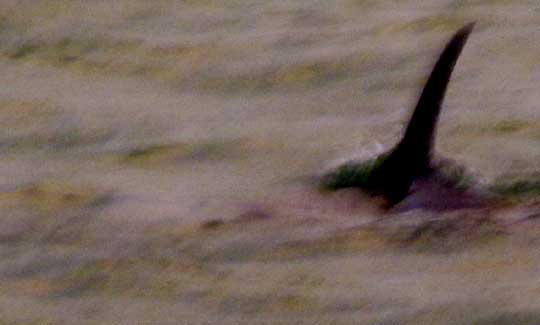Excerpts from Jim Conrad's
Naturalist Newsletter
from the May 24, 2015 Newsletter issued from Río Lagartos, on the Yucatan Peninsula's northern coast (~N21.60°, ~W88.16°), Yucatán state, MÉXICO
DOLPHINS AT SUNSET
Paco and I were returning late from a flamingo tour with a couple from British Colombia. The visitors had shown special interest in dusk's dramatic, stormy-looking, pre-rainy-season, low-slanting-sunlight-highlighted clouds, so Paco asked if they'd like to make a quick run through the canal in front of Río Lagartos to see the sun set over the Gulf of Mexico. It was spectacular, as you can see below:

The highlight of the moment, however, wasn't the sunset but rather the pod of feeding dolphins around us. Their top fins, or dorsals, alternately for two or three seconds would appear above the water, often followed by their rear, horizontally arranged flippers, or flukes, as they dove into deeper waters. Paco said it was normal at sunset at this time of year to see this.
Of course I tried to get a good picture, but it was all happening too fast. Only by pointing the camera at a busy spot and waiting for a fin to pop up could I get a picture, and with the low light and bobbing boat, the best I could do was what's shown below:

Several dolphin species are possibly found in waters off Río Lagartos, and a fuzzy fin picture isn't much help in distinguishing them. The following dolphin species are listed for waters of the Gulf of Mexico off Río Lagartos:
Bottlenose Dolphins seem to be the most commonly reported, so maybe we were seeing them, but who knows? They all have top fins looking like what's in our photo, and horizontal flippers. Around forty species of dolphin worldwide are distributed throughout 17 genera.
You might be interested in a March, 2015 article in the New York Times entitled "Gulf of Mexico Turns Deadly for Dolphins."